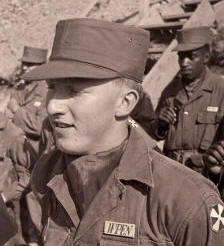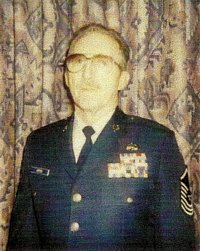|
We need your help to keep the KWE online. This website
runs on outdated technology. We need to migrate this website to a modern
platform, which also will be easier to navigate and maintain. If you value this resource and want to honor our veterans by keeping their stories online
in the future, please donate now.
For more information, click here.
|
|||||||||||||||
 |
|||||||||||||||
| Back to "Memoirs" Index page | |||||||||||||||
S.M.Sgt. Gilbert J. "Jerry" Oppen ( Ret.)Sun City, AZ - "I joined the Army at age 17 and went to Korea as soon as I turned eighteen and a half (the legal age for combat service). " - Jerry Oppen <---Gilbert Oppen age 18, a year after joining - Korea 1952 |
|||||||||||||||
Memoir Contents:PrefaceI joined the Army at age 17 and went to Korea as soon as I turned eighteen and a half (the legal age for combat service). I served in the 24th AAA Battalion, Battery "A", Eighth Army, for the last year of the conflict. I reenlisted, transferred to Japan, and took an overseas extension. I shipped out seven days after the cease fire. While I was waiting to board ship for Japan, I was put on guard duty. I locked my duffle to my bunk. When I returned, everything was gone, including all my pictures and addresses. I have often wondered if there is any way I can get a roster of the members of that outfit during that time period. I was discharged in 1957, and stayed out and raised a family until 1976. I then joined the Idaho National Guard, serving five years with them. I then went to Seattle and joined the Washington Air Guard. I stayed there until age 60, retiring with 25 years. While in the air guard, I served for one year as the unit's senior NCO advisor and was able to attend the senior NCO academe at Gunter Air Base (annex of Maxwell AB). While I was in the Idaho Guard, I attended their academy. While in attendance I wrote a paper entitled, "Why We Went to War in Korea." Why We Went to War in Korea
This paper is an effort to disseminate some of the facts of this history. ** In the 19th century Korea was a subject state of the Chinese empire. After the end of the Sino-Japanese War in 1895, Korea came under Japanese control. In 1910 Korea lost her independence in a "formal Japanese annexation." After the attack on Pearl Harbor in 1941 by the Japanese, American statesmen realized that Korea was one of the "first victims of Japanese aggression." At the Cairo Conference 1 December 1943, the United States, China, and Great Britain issued an official communique saying: "The aforesaid three great powers, mindful of the enslavement of the people of Korea, are determined that in due course, Korea shall become free and independent." (1) The U.S. State Department urged that an international administration representing the United States, Great Britain, China, and the USSR prepare Korea for independence. This was suggested in February 1945 by Roosevelt to Stalin, and in May 1945 Stalin agreed. At the Potsdam Conference the allies restated their commitment to the Cairo declaration. On 6 August 1945 the B29 "Enola Gay" dropped the first atom bomb on Hiroshima. (2) Two days later on 8 August 1945 the Soviets declared war on Japan and announced their "adherence to the Potsdam declaration." On 9 August the second atom bomb was dropped on Nagasaki and Japan surrendered unconditionally on 14 August 1945. (2) At the time of the Japanese capitulation, Russian troops were entering Korea and the Joint Chiefs of Staff proposed that the Russians demobilize the Japanese forces north of the 38th parallel and the United States south of the 38th. This was regarded by the United States as a temporary emergency partition expedient only for disarmament of the Japanese troops in Korea. By December 1945, the Russians were reported building field fortifications on their side of the 38th parallel. Late December 1945 in Moscow a commission was set up by the foreign ministers to represent the two military commands in Korea (Russia and the United States). It was to assist in formation of a provisional government. "It was never able to find acceptable solutions to the Korean problem." (4) In September 1947 the United States requested the United Nations take up the problem of unification. They decided, over Soviet opposition, that a national government be established by nationwide elections. Elections were held on 10 May 1948, but the Communists refused to allow the elections in the area under their control, north of the 38th parallel, and said they were "illegal." The United Nations General Assembly declared the ROK Government to be the only lawful government in Korea and established a United Nations commission on Korea which was to bring about unification. The Soviet Union refused to participate, and on 25 August 1948 held elections and established the "Supreme Peoples Assembly" at Pyongyang, "a government for all of Korea." A month later the Soviets announced they would withdraw all Russian troops by January 1949 and proposed all foreign troops be removed. This was welcomed by the United States who had wanted withdrawal for more than a year. The United States began plans to train and equip the South Korean armed forces and extract its 45,000 troops. By the end of June 1949 the last units departed Korea and on 30 June 1949 General MacArthur deactivated the command "U.S. Army Forces in Korea" (USAFIK). A 500 person advisory group remained, supervised by the U.S. Ambassador in Seoul. At this time the ROK had 82,000 troops and 18,000 police, half the amount the ROK government thought was necessary. These were armed with defensive weapons, mostly small arms and mortars. After the evacuation of U.S. troops, the Far East command no longer had any responsibility for the defense of Korea. The United States encouraged continued United Nations interest and would cooperate in finding a solution to the Korean solution. In January 1950 the United States Secretary of State, Dean Achison, stated Korea was not part of the defensive perimeter of the United States, but would "unilaterally defend areas which were strategically important to us and would participate with the United Nations to check aggression against other free people in the Pacific." (3) In 1949 and 1950 a North Korean army was forming around two divisions that had seen service with Soviet forces during the Japanese occupation of Korea and three divisions that had seen service with Chinese Communists against the Chinese Nationalists. In May 1950 the Korean Military Advisory Group (KMAG) knew the North Korean Peoples Army (NKPA) had six regular divisions located between the 38th and 39th parallels, and it was suspected of forming seven more in the north near Manchuria. By 25 June the NKPA totaled 100,000 troops outfitted with Soviet offensive military equipment, including several Soviet-built T-34 tanks. The North Korean Air Force (NKAF) had about 162 airplanes, of which 132 were combat planes. On the Sunday morning of 25 June 1950 at 0400 hours, under the cover of bad weather, as General MacArthur said, "They struck like a cobra." (5) Thus began the first war in American history limited by political design--not by technology, ability, or power. The communist aggression in Korea was "positive proof that Russia and her satellites were willing to risk general war.... The limited military strength of the United States had not been a course for peace but had tempted the communists to exploit war as an instrument of national policy." "The final recognition of this fact by the American people, made it possible to start the rebuilding of the Armed Forces to the minimum strength required for the security of the United States." (6) Acknowledgement to NotesAcknowledgement is given to the author, his staff and the many sources used to write the history, in the books: "The United States Air Force in Korea 1950-1953" by Dr. Robert Frank Futrell, written at Maxwell Air Force Base, Alabama, from March 1957 to November 1958. It was approved by the Air Force "without a suggestion for changing" any of the book. Most all information, dates, places, facts and quotes in this paper were taken from the aforementioned book.
|
|||||||||||||||
|
|||||||||||||||
 |
|||||||||||||||



